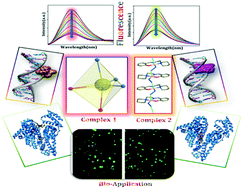Developing novel zinc(ii) and copper(ii) Schiff base complexes: combined experimental and theoretical investigation on their DNA/protein binding efficacy and anticancer activity†
Abstract
Two new metal complexes, namely, [Zn2(LH)2(N3)4] (1) and [Cu(L)(N3)] (2), have been derived from a Schiff base ligand, (E)-2-(((2-(piperidine-2-yl)ethyl)imino)methyl)phenol (HL), employing azide as the secondary anionic residue. Single crystal structural analyses suggest the protonation of piperidine N during the crystallization of the dinuclear motif of complex 1, which is non-operative in the case of complex 2, governing the diverse denticity of the ligand backbone. After a thorough characterization, the complexes are investigated to check their bio-medical applications. Both complexes exhibit impressive binding efficacy with CT DNA as well as Human Serum Albumin (HSA) protein, as revealed from their electronic spectroscopic measurements. A sharp fluorescent quenching of the DNA-EtBr conjugate and HSA protein was encountered separately via the addition of complexes 1 and 2 with the quenching constant in the order of ∼105 M−1. A theoretical inspection through the molecular docking study has also been introduced to justify the experimental outcomes along with the determination of the interaction site and energy. Finally, both complexes are tested for anticancer activity using HeLa (cervical cancer cell) and PA1 (ovarian cancer cell) cell lines through the in vitro MTT assay, which suggests a better cancer cell killing efficacy of complex 2. The applicability of complexes 1 and 2 within the normal cell (hEG) has been concurred through the determination of much higher LD50 values, indicating significantly lower cytotoxic effect on the normal cell line. Furthermore, the haemolysis assay indicates no consequential impact of complexes (1 and 2) on the RBC. Finally, the anti proliferative activities of both the complexes towards carcinoma cell lines were analysed through various nuclear and cellular staining techniques, unveiling the cell death mechanism.



 Please wait while we load your content...
Please wait while we load your content...